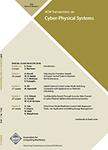版权所有:内蒙古大学图书馆 技术提供:维普资讯• 智图
内蒙古自治区呼和浩特市赛罕区大学西街235号 邮编: 010021

作者机构:Nanjing Univ Posts & Telecommun Jiangsu High Technol Res Key Lab Wireless Sensor 9 Wenyuan Rd Nanjing 210046 Jiangsu Peoples R China Nanjing Univ Posts & Telecommun Nanjing Jiangsu Peoples R China Xiangtan Univ Minist Educ Key Lab Intelligent Comp & Informat Proc Key Lab Hunan Prov Internet Things & Informat Sec North Second Ring Xiangtan Hunan Peoples R China Nanjing Univ Posts & Telecommun Jiangsu High Technol Res Key Lab Wireless Sensor Sch Engn Nanjing 210046 Jiangsu Peoples R China
出 版 物:《ACM TRANSACTIONS ON CYBER-PHYSICAL SYSTEMS》 (ACM Trans. Cyber-Phys. Syst.)
年 卷 期:2019年第3卷第4期
页 面:1–19页
核心收录:
基 金:National Key Research and Development Program of China [2018YFB0803400] Nature Science Foundation of Jiangsu [BK20170039] National Science Foundation of China [61873131, 61572261] Hunan Provincial Natural Science Foundation [2018JJ1025] Hunan Province Science and Technology Project Funds [2018TP1036]
主 题:Behavior learning WiFi channel state information improved linear discriminant analysis logistic regression algorithm
摘 要:In recent years, rapid development of sensing and computing has led to very large datasets. There is an urgent demand for innovative data analysis and processing techniques that are secure, privacy-protected and sustainable. In this article, taking human activities and interactions with Cyber-Physical Systems (CPS) into consideration, we propose a human behavior learning system based on Channel State Information (CSI) utilizing a series of algorithms for data analysis and processing. Aiming to recognize a set of gestures, our system is designed based on the observation that different gestures have different effects on signals and specific gesture signals have a unique energy spectrum. Specifically, an improved Linear Discriminant Analysis Algorithm (I-LDA) is devised to reduce the dimension of human behavior signals. Additionally, behaviors are learned by Logistic Regression Algorithm (LRA). Bandwidth ratios in an energy spectrum are selected as features to eliminate the impact of speed differences on results. The system is based on commercial off-the-shelf WiFi devices and we conduct a large number of experiments in a typical indoor environment to evaluate its performance. Experimental results show that our system is robust with average recognition accuracy of up to 96%.